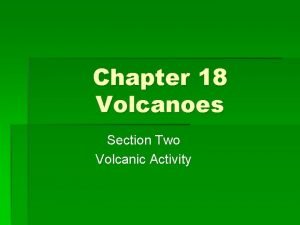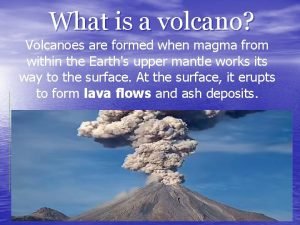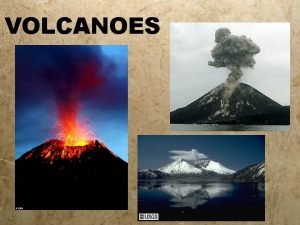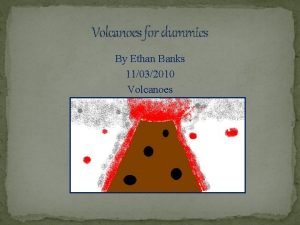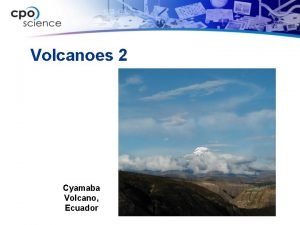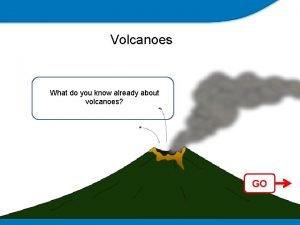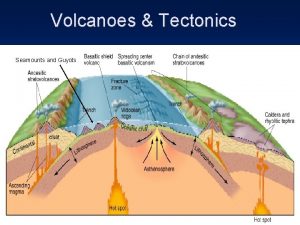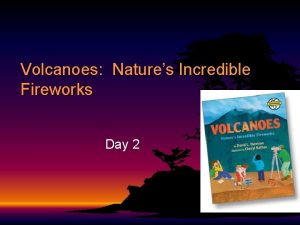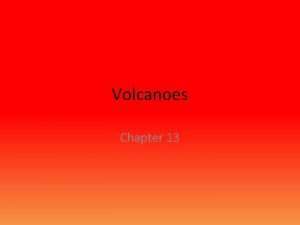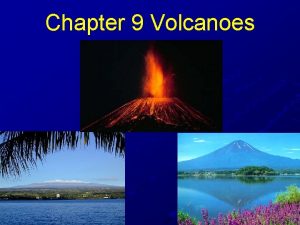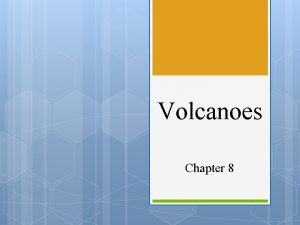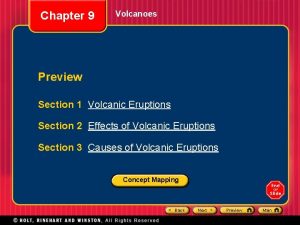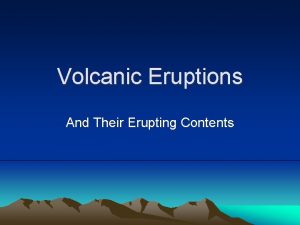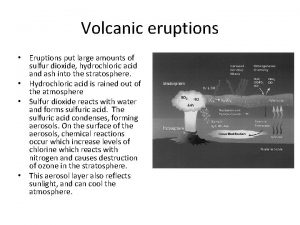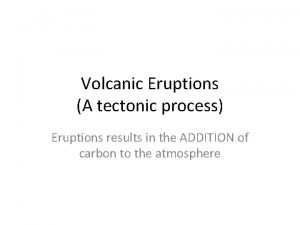Chapter 13 Volcanoes Section 2 Volcanic Eruptions Section










- Slides: 10

Chapter 13 - Volcanoes Section 2: Volcanic Eruptions

Section 2 Objectives � Explain how the composition of magma affects volcanic eruptions and lava flow. � Describe the five major types of pyroclastic material. � Identify the three main types of volcanic cones. � Describe how a caldera forms. � List three events that may signal a volcanic eruptions.

Windows to Earth’s Interior � 2 › general types of lava Mafic: magma or rock rich in Mg and Fe; commonly dark in color �Commonly makes up oceanic crust �May also make up continental crust › Felsic: magma or rock that is rich in lightcolored silicate materials �Makes up continental crust

Types of Eruptions � Viscosity – the resistance of a liquid to flow; determined by magma’s composition �This can affect the force with which a volcano may erupt �Mafic magmas are runny with low viscosity and typically cause QUIET eruptions (typically oceanic volcanoes – Hawaii) �Felsic magmas are very sticky and therefore highly viscous. �They can trap large amounts of dissolved gases, which leads to more EXPLOSIVE eruptions.

Lava Flows � Pahoehoe – mafic flows that cool & form a crust, continues to flow causing wrinkles in crust; “ropy” lava flows � Aa – forms if crust deforms rapidly or grows too thick to wrinkle, and surface breaks into jagged chunks. › Same composition but different textures due to gas content, rate and slope of flow � Blocky – Higher silica and is more viscous, forming large blocks of volcanic rock when cooled

Explosive Eruptions � Felsic lavas of continental volcanoes such as Mount St. Helens tend to be heavier and stickier (more viscous) � Contain large amounts of trapped gases, such as carbon dioxide and water vapor � During an eruption, gases escape and molten and solid particles are thrown into the air › Pyroclastic material: fragments of rock that form during a volcanic eruption

Types of Pyroclastic Material � Particles are classified according to size �Volcanic ash: particles < 2 mm in diameter �Volcanic dust : particles < 0. 25 mm in diameter �Lapilli: “little stones” < 64 mm in diameter �Generally fall near the vent �Volcanic bombs: clumps of red-hot lava that spin and cool in the air; round or spindle �Volcanic blocks: solid rock blasted from the vent; may be as large as a small house

Types of Volcanoes � Table 1, page 328 � Lava &/or pyroclastic material ejected during both quiet &/or explosive eruptions build up around the vent � Forms 3 Types of Volcanic Cones › Shield volcanoes: Broad at base with gentle sloping sides; quiet eruptions; mafic lava › Cinder cones: Very steep slope; explosive eruptions with cones of pyroclastic material › Composite volcanoes: alt. layers of hardened lava flows and pyroclastic material; a. k. a stratovolcanoes; lg. volcanic mtns.

Calderas � Large circular or basin-shaped depressions in the ground › Form when the magma chamber below a volcanic cone collapses › Figure 4, page 329 › Eruptions discharge large amounts of magma can cause a magma chamber to collapse › Krakatau: volcanic island in Indonesia exploded in 1883 forming a caldera with diameter of 6 km › May fill with water to form lakes

Predicting Volcanic Eruptions � Earthquake activity may signal a volcanic eruption before it occurs › Due to increased pressure, increased temps, or fracturing of surrounding rock › Also increased strength and frequency of quakes � Patterns › › in Activity Sides of volcano may bulge as magma moves Instruments measure tilt of ground on slopes Knowledge of previous eruptions Daily measurements vs. past measurements
 Chapter 8 earthquakes and volcanoes
Chapter 8 earthquakes and volcanoes What are plutons that cause overlying rocks to bow upward
What are plutons that cause overlying rocks to bow upward Chapter 18 volcanic activity
Chapter 18 volcanic activity Crust volcano
Crust volcano How are volcanoes classified?
How are volcanoes classified? Volcanoes for dummies
Volcanoes for dummies Where do most volcanoes occur
Where do most volcanoes occur Extreme earth
Extreme earth What do you already know about volcanoes?
What do you already know about volcanoes? Three main ways volcanoes are created
Three main ways volcanoes are created Volcanoes nature's incredible fireworks
Volcanoes nature's incredible fireworks


